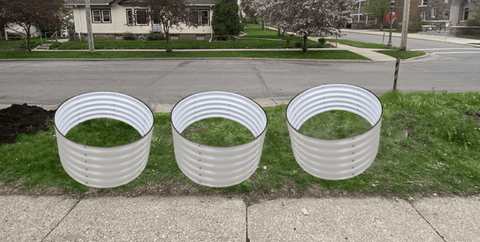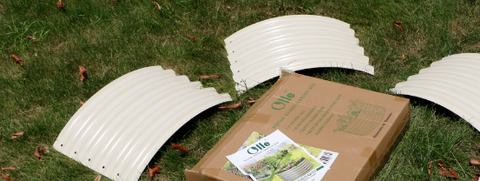9 Things to Put at the Bottom of the Raised Garden Bed
Raised garden beds are gradually becoming popular; It has several advantages over ground-based gardening. One of the most common questions about gardening with a raised garden bed is what you need to place at the bottom of the garden beds.
A barrier is arranged at the bottom of the raised garden bed to prevent weeds from growing; As we all know, the fewer weeds in the garden, the better.
Gardeners have a wide choice of raised garden bed barriers. You can use newspapers, cardboard, leaves, or nothing. Keep in mind that each barrier option has advantages and disadvantages to consider before using it.

Let's learn more about the raised garden bed and what you need to know.
Do you need anything at the bottom of the raised garden bed?
There is no need to add materials or barriers to the bottom of the garden bed. Many gardeners never use any barriers, as long as the bed is on the grass.
If your garden bed is less than six inches deep, you should not use a barrier because setting a barrier in a shallow bed may prevent the growth of plant roots.
It's no big deal to leave nothing at the bottom of the garden bed, but since weeds will not be restrained, you need to use some kind of covering on the top of the garden to prevent weeds from growing. Weeds are not only ugly; They compete with your plants for important nutrients. You want your plants to get all the nutrients, not weeds!
9 things to put at the bottom of the raised garden bed
- Newspapers
Newspapers are one of the cheapest things to put at the bottom of a raised garden bed. The price of the daily newspaper is less than $2. If you ask your friends and family, they will probably give you the newspaper they used.
It's easy to use newspapers at the bottom of the raised garden bed. All you have to do is put the sheets on the bottom of the bed and fill the garden bed with soil.
Newspapers decompose more slowly than most people think, but over time, they will decompose well. Once decomposed, the newspaper will release carbon into the soil, which is the nutrient required by plants. Carbon nourishes microorganisms living underground.
Remember, the thicker the layer, the slower the newspaper will decompose. So if you want to avoid decomposition, stack more newspapers together!
- Cardboard
Cardboard is another popular barrier material for raised garden beds. It is as cheap and rich as a newspaper. In most cases, if you ask friends and family, you will be able to buy cardboard at a cheap or almost free price.
Paperboard has some advantages and disadvantages. It is thicker, so it will decompose over time, but it will take a long time to happen. Cardboard takes at least four to six months to decay, but some types of cardboard decompose slowly.
Make sure to avoid using any cardboard with smooth printing, so as to include cereal boxes, soda boxes and shoe boxes. This type of ink is different from the soybean ink used in newspapers; Glossy ink will release chemicals and toxins that you do not want to be close to plants.
- Landscape fabric
Landscape fabrics are an investment, but some fabrics are worth it. Some brands can be used for more than ten years, so if you plan to garden for many years, it may be worth considering.
The greatest advantage of using landscape fabrics is that they are durable and resistant to decomposition. Some people use gardening fabrics on the top of the garden bed instead of the bottom. If you want to try, all you have to do is cut or burn holes in the material to plant seedlings.
Although it is a fabric, it is permeable, so water will pass through it. In addition, it can block sunlight, so it can inhibit weeds.
In general, landscape fabric is a good choice, but it costs money. So if you have a big garden, you may not be able to afford it. In addition, please make sure that you do not mix garden green fabrics with garden green plastics; dissimilarity!

- B Website
Another excellent alternative to landscape fabrics is burlap. Its service life is not as long as that of landscaping fabric, but it takes several years to decompose. It allows water to pass through, inhibits weeds, and is environmentally friendly. Burlap is made from the fibers of jute plants, so you don't have to worry about it hurting your plants.
It comes from plants!
The only disadvantage of using burlap is that it wears easily, and cutting it to the right size for your needs can be frustrating.
- Leaves
If you want to use something for free at the bottom of the raised garden bed, consider using backyard leaves. It is very easy to fill a raised garden bed with leaves at the bottom of the garden bed. The leaves take 6 to 12 months to fully decompose, but they decompose.
The more leaves you put at the bottom of the raised garden bed, the longer it takes to decompose! When leaves break down, they add nutrients, such as carbon, to the soil. Therefore, leaves can not only inhibit weeds, but you will eventually get healthier, nutrient rich soil.
- Hardware structure
If you struggle with rodents or animals on the garden bed, hardware fabric is a good solution. It is not used to remove weeds; All holes can't control weeds, but they help prevent plants from being damaged.
If you don't worry about weeds, but want to stop burrowing animals, the hardware structure is great. It will not decompose, it will last for years. So, although a little expensive, once laid, it will last for several years.
You can also combine the hardware structure with any other barrier material!
- Stone
Most people will never think of arranging the bottom of the garden bed with stones, but stones, rocks and pebbles are a good choice. This is unique because rocks do not decompose, so they become permanent barriers.
Of course, the use of stone and rock has its advantages. Unfortunately, it takes a lot of stones to cover the bottom of the raised garden bed, so you may need to buy rocks. This will soon become expensive.
Even if you can fill most of the bed with stones, there may be gaps large enough for weeds to grow around. You can try to solve this problem by placing smaller stones around larger stones to narrow the gap.
However, the biggest disadvantage is poor drainage. Water can't go through rocks, so it has nowhere to go. This can lead to wet soil and ponding, as well as other problems. The only way to solve this problem is to leave a gap between the stones, but the weeds will grow.

- Wood
It is easy to forget that wood can be used at the bottom of the raised garden bed. You can use logs, boards, branches, sawdust or anything else you want to use.
Wood is more durable than other materials and takes years to decompose, but it does. Of course, it really depends on the kind of wood you use, but untreated wood will rot within a few years.
If you are using a plank that may prevent water from escaping, you need to ensure that you add drain holes to the wood. This is also to ensure that you never use pressure treated wood because it contains potentially dangerous chemicals to plants.
- None!
Of course, you don't need to put anything at the bottom of the raised garden bed, so you can leave the grass there. This does not help prevent weeds, but it does not require setup or trouble at all.
You don't have to put anything at the bottom of the raised garden bed, but if you want to curb weeds, you can try several materials. From newspapers to stones, some things will fit your budget and garden.
